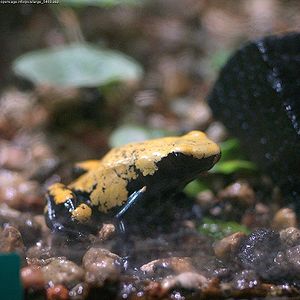Adelphobates
| Adelphobates | ||||||||||||
|---|---|---|---|---|---|---|---|---|---|---|---|---|

Adelphobates galactonotus |
||||||||||||
| Systematics | ||||||||||||
|
||||||||||||
| Scientific name | ||||||||||||
| Adelphobates | ||||||||||||
| Grant et al., 2006 |
Adelphobates is a genus of poison dart frogs (Dendrobatidae). It currently consists of three relatively small species that can be found in different regions of Brazil .
Types and characteristics
The species in the genus Adelphobates are small to medium-sized poison dart frogs. All species are conspicuously colored and usually have a varnish black basic color with differently sized orange and white spots or larger body areas. A. galactonotus in particular has a very wide range of variants, while A. castaneoticus and A. quinquevittatus vary only very little in their coloration.
However, the genus itself was not described on the basis of morphological, but rather on the basis of molecular biological characteristics. Due to their genetic characteristics, the three species form a clade that is clearly separated from other genera , which justifies its own genus. As a common feature apart from genetics, the animals lay light-colored clutches and also have light-colored larvae.
Occasionally a fourth species, Adelphobates captivus , is mentioned. Since 2008 this has been carried in a newly established genus under the name Excidobates captivus .
distribution
The species of the genus live in Brazil - A. quinquevittatus also in eastern Peru - and occur only south of the Amazon and west of the Río Ucayali . They are inhabitants of the lowland rainforests along the south side of the Río Amazonas. A. castaneoticus and A. galactonotus are sometimes found sympatric in the state of Pará .
Way of life
All species are active in the foliage layer of their forest habitats during the day and feed on small insects such as ants and termites .
The larvae after hatching to small water retention in plants ( phytotelmata distributed), wherein A. castaneoticus and A. galactonotus very often water-filled fruit shells of the Brazil nut ( Bertholletia excelsa ) use. Also A. quinquevittatus uses the fruit peel, the larvae but are also often sold in other miniature waters in leaf axils or tree holes.
Systematics
The genus Adelphobates was introduced in 2006 by Grant and others as part of a major overhaul of the poison dart frog. The species A. castaneoticus , discovered in 1990, is considered to be a type of the genus . All species previously belonged to the genus Dendrobates and were accordingly separated out as a separate taxon and compared to this as sister taxon . Together with the genus Oophaga , these three genera in turn represent the sister taxon of Minyobates , Phyllobates and Ranitomeya .
etymology
The name Adelphobates is derived from the Greek name adelphos = twin or brother. It refers to the longstanding collaboration between Charles W. Myers and John W. Daly. Both worked together with the poison dart frog for decades and have described several species and deciphered other important results from the biology of the animals.
species
There are currently three species in the genus Adelphobates :
As of October 23, 2017
- Adelphobates castaneoticus (Caldwell and Myers, 1990)
- Adelphobates galactonotus (Steindachner, 1864)
- Adelphobates quinquevittatus (Steindachner, 1864)
A. quinquevittatus was used as Dendrobates quinquevittatus for a long time as a collective name for different species and included different Dendrobates species from Brazil, Peru and Ecuador. After the identification of individual species, these were put together in a species complex and named Dendrobates quinquevittatus s. l. designated. In 1990 the species was re-described and thus clearly differentiated from other species; in the same publication A. castaneoticus (formerly D. castaneoticus ) was described for the first time and placed in the relationship of A. quinquevittatus and D. ventrimaculatus , today Ranitomeya ventrimaculata . The latter was differentiated from today's Adelphobates species by genetic studies in 2003 , at the same time A. galactonotus, previously suspected to be related to Dendrobates tinctorius , was added to the group.
Danger
The three species of the genus because of their suspected relatively wide distribution area and the presumed large population in the IUCN Red List classified as endangered ( "Least Concern").
Individual evidence
- ↑ American Museum of Natural History: Amphibian Species of the World ( page no longer available , search in web archives ) Info: The link was automatically marked as defective. Please check the link according to the instructions and then remove this notice.
- ↑ T. Grant, D. R. Frost, J. P. Caldwell, R. Gagliardo, C. F. B. Haddad, P. J. R. Kok, D. B. Means, B. P. Noonan, W. E. Schargel, W. C. Wheeler: Phylogenetic systematics of dart-poison frogs and their relatives (Amphibia, Athesphatanura, Dendrobatidae) . In: Bulletin of the American Museum of Natural History. 299, 2006.
- ^ JP Caldwell, C. W. Myers: A new poison frog from Amazonian Brazil, with further XX revision of the quinquevittatus Group of Dendrobates. (PDF; 5.3 MB) In: American Museum Novitates. 2988, 1990, pp. 1-21.
- ↑ M. Vences , J. Kosuch, R. Boistel, C. F. B. Haddad, E. La Marca, S. Lötters, S. Veith, M. Veith: Convergent evolution of aposematic coloration in Neotropical poison frogs: a molecular phylogenetic perspective. (PDF; 186 kB) In: Organisms, Diversity & Evolution. 3, 2003, pp. 215-226.
- ↑ Dendrobates castaneoticus in the endangered Red List species the IUCN 2008. Posted by: Miguel Trefaut Rodrigues, Claudia Azevedo-Ramos, 2004. Retrieved on 13 May, 2009.
- ↑ Dendrobates quinquevittatus in the endangered Red List species the IUCN 2008. Posted by: Miguel Trefaut Rodrigues, Claudia Azevedo-Ramos, 2004. Retrieved on 13 May, 2009.
- ↑ Dendrobates galactonotus in the endangered Red List species the IUCN 2008. Posted by: Miguel Trefaut Rodrigues, Claudia Azevedo-Ramos, 2004. Retrieved on 13 May, 2009.
Web links
- Thomas Ostrowski, Thorsten Mahn: Species description Adelphobates castaneoticus. Status: June 2008 (please use navigation for the genre profile)